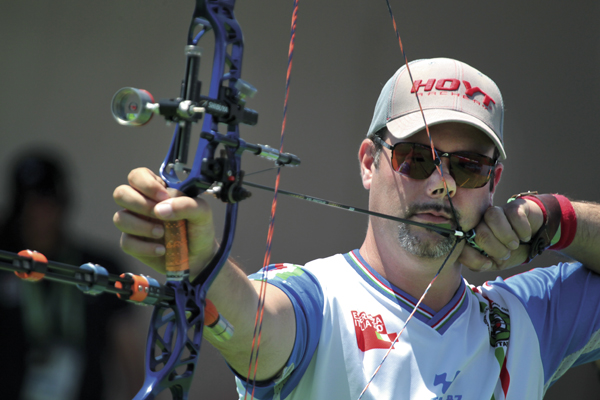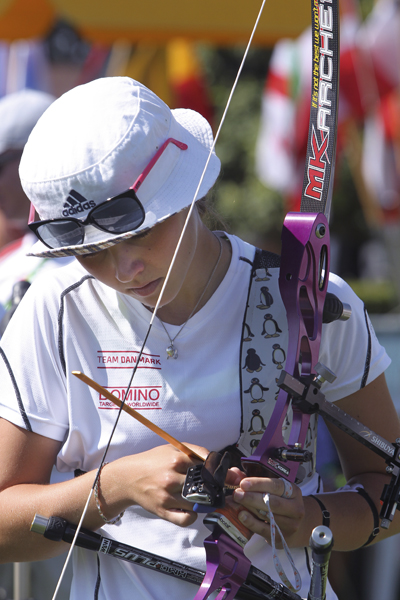Roy Rose explains why the very human desire to experiment can sometimes hold your archery back
We’re told change is inevitable, except from a vending machine, and certainly most life experiences will often require change in order to function successfully. But in our world of competitive archery, change, motivated by the human desire to assess, judge, and fiddle, is very much the enemy.
Archery is one of the very few unique sporting endeavours which requires but a simple series of actions, that only lasts for a short duration but at the same time demands meticulous duplicative execution, arrow after arrow, if one is to achieve repetitive accuracy.
Most sports accept the error factor is inevitable, and as such matches and competitions are structured to allow a competitor repeated opportunities to retrieve points from less-than-positive lapses. For example, the tennis champ can be two sets down, and win in five, and the golfer’s misdirected drive can be retrieved with a quality chip and putt. However, the wonderful plus our sport enjoys – that is, its simplicity – is countered by an absolute need to be religiously duplicative, and an errant arrow yields points lost that cannot be retrieved. The archer has no opportunity to un-ring the bell.
The end result of the archer’s quandary is that he or she must develop a setup and execution process which is (as close as humanely viable) infallible. This demands two imperatives. Firstly, it needs a speedy arrival at the said setup and shot process. Secondly – and this is where change becomes our enemy – an archer needs to have a focused appreciation that they must resist all desire to assess, fiddle, re-assess, and fiddle again. One cannot attain repetitive, video replay-like form and execution, which is the essence of accuracy, if we are constantly in the throes of change.

Some top compound archers will use the same release aid for years, as with Familiarity comes comfort
One cannot attain repetitive, video replay-like form and execution, which is the essence of accuracy, if we are constantly in the throes of change.
There does come a point where decisions have to be made as to equipment choices, and a set of established, accepted basics regarding an archer’s form and dispatch of the arrow have to be learned. With more practice and confidence, the archer can then add in their own small idiosyncrasies in order to obtain the most comfortable setup and shot process for them, and this is crucial because, as I’ve always maintained, comfortable is repeatable.
All this takes time, but having reached this point, the archer desirous of moving to a higher, more accurate level of performance, which hopefully may take him or her to national or even international competition if that is what he or she wishes, must now focus definitively on absolute repetitive form.
Herein lies the challenge. The challenge to resist change. If we fiddle with any part of our setup and our shot process, our aim of developing that over-and-over, ingrained sequence of actions, will be disturbed, and that goal of duplicative functioning will retreat back to step one, and result in on-going frustration.
If we examine the truly great shooters, recurve and compound, both past and present, the pattern is clear. The form and execution we witnessed a decade ago remains today. As a further example, many top compounders retain their original release aids, the feel and use of a particular model being crucial to their performance. Sure the pros are required to update their sponsor’s bow models, but in many cases the latest offering is merely a tweak of the previous design, and their well-practiced form remains 100 per cent intact. Technology may advance, but the established tried and true action sequence from the stance to the follow-through is indelibly set in stone.
We are all aware of the archery idiom that tells us we don’t need to do it right each time, we just have to do it the same each time. Every champion has some minor aspect of their form which defies the generally accepted procedure. Some can even exhibit major flaws, things that no coach would impart to their charges, but that are part of a top archer’s ingrained physical and mental pathway which, when repeated with unerring precision, adds up to elite accuracy and serves them superbly. I have witnessed many promising shooters lose their way by constantly changing bows, or release aids, or altering every form step and trying every execution method that comes to their attention. While this continuous search for some sudden form or equipment enlightenment invades their thinking, there is absolutely no likelihood that an ingrained, repetitive shot process can materialise.
The archer who wishes to be the best he or she can be must work through the established basics, settle on equipment, and a comfortable setup, add in a shot execution system through the clicker, or on the break of the release aid, which they trust implicitly, and then practice the heck out of it. They must do this resisting any desire to judge, chop and change, assess and re-assess. This, combined with focus and patience, will help the habit of shooting down accuracy avenue become a physical and mental reality.
The old archery adage that emphasises just how simple our sport can be – “Step one: Shoot an X. Step two: Repeat step one” – may provide a smile if you haven’t heard it before, but the archer who continues, arrow after arrow, to repeat step one, is destined for greatness. This can only happen if we keep the archery change at bay.
It’s that arena of learning just past the absorption of the accepted basics that will determine the future status of the archer. It is imperative from that point onwards that we bring that stability of functioning, which allows us to gel all aspects of our process into a harmonious unit, to bear. It can be boring, it can be trying, and it may well be difficult to resist the natural desire to make changes which we believe, at the time, will be productive. But honing that form into robot-like duplication will be your ultimate reward, and with it comes top-level accuracy.
It’s a simple mandate that we all strive to improve. Don’t let the temptation of ongoing change thwart your efforts to be the best you can be.


